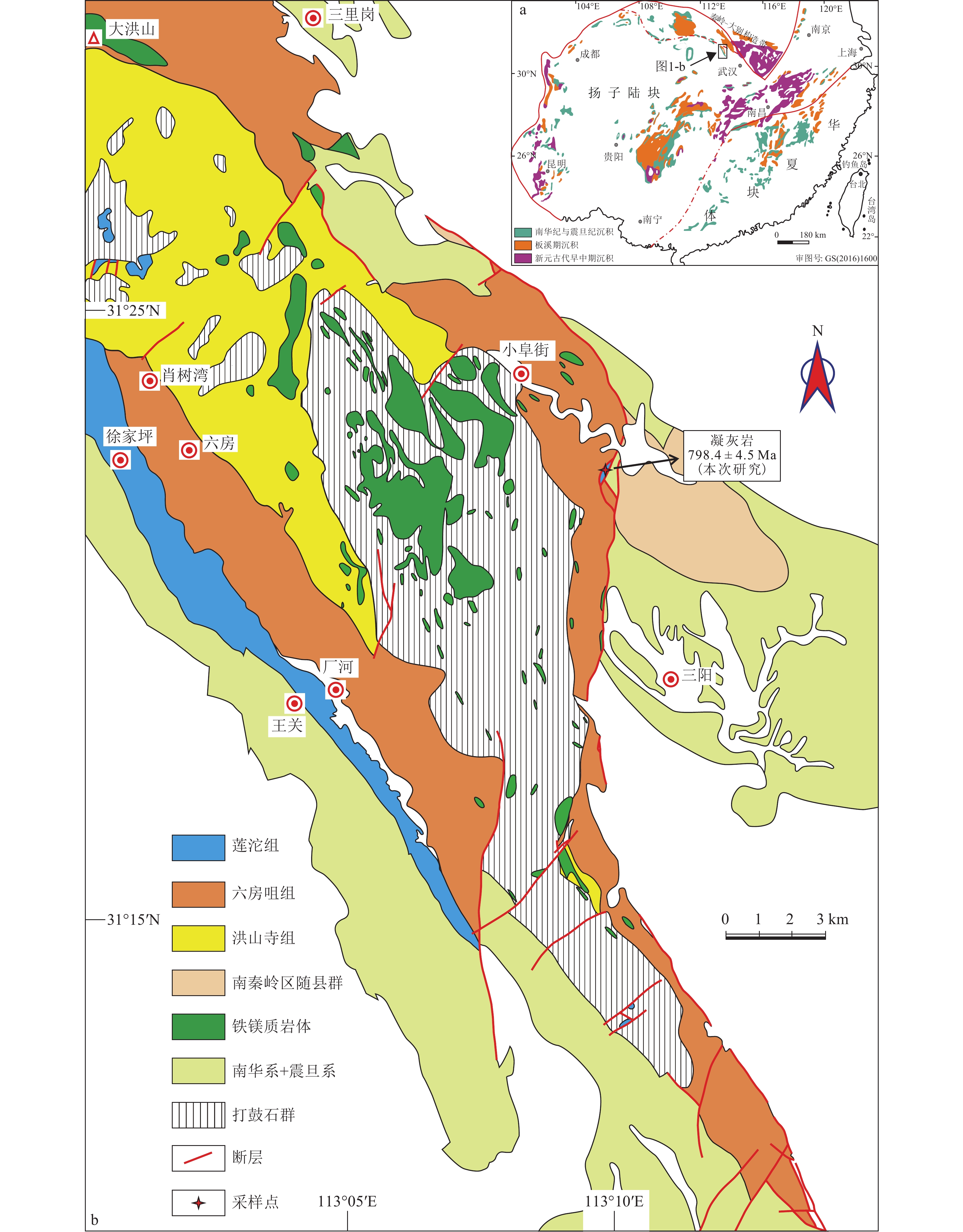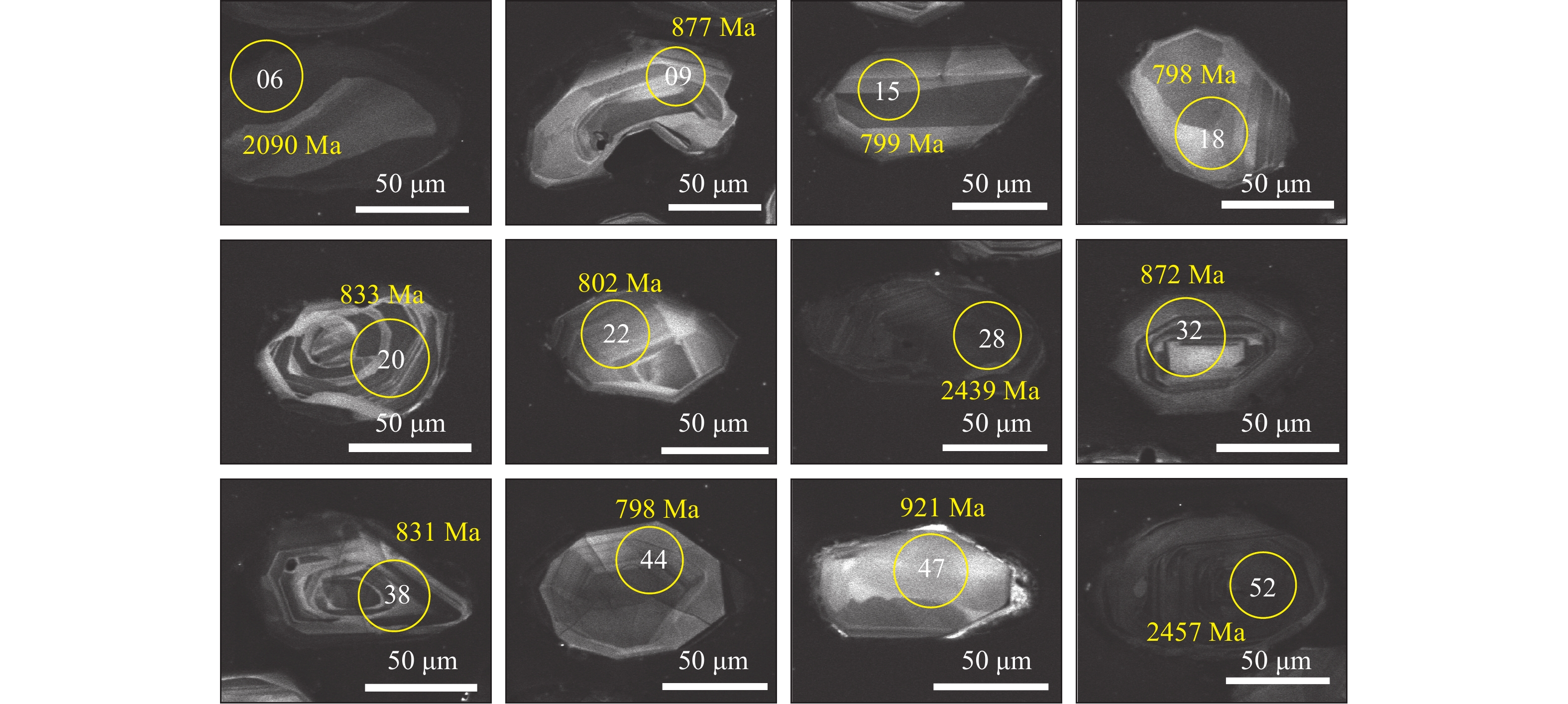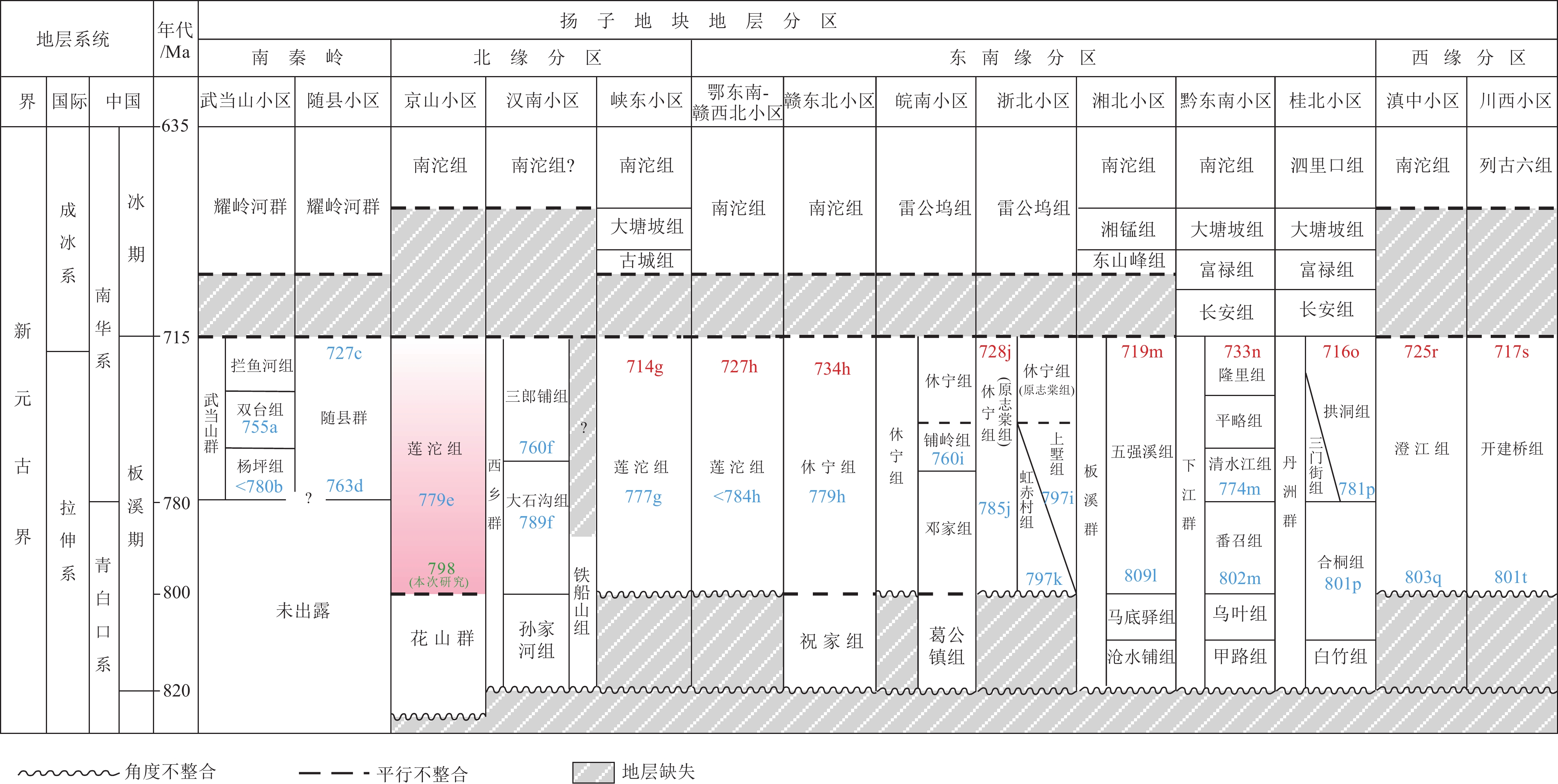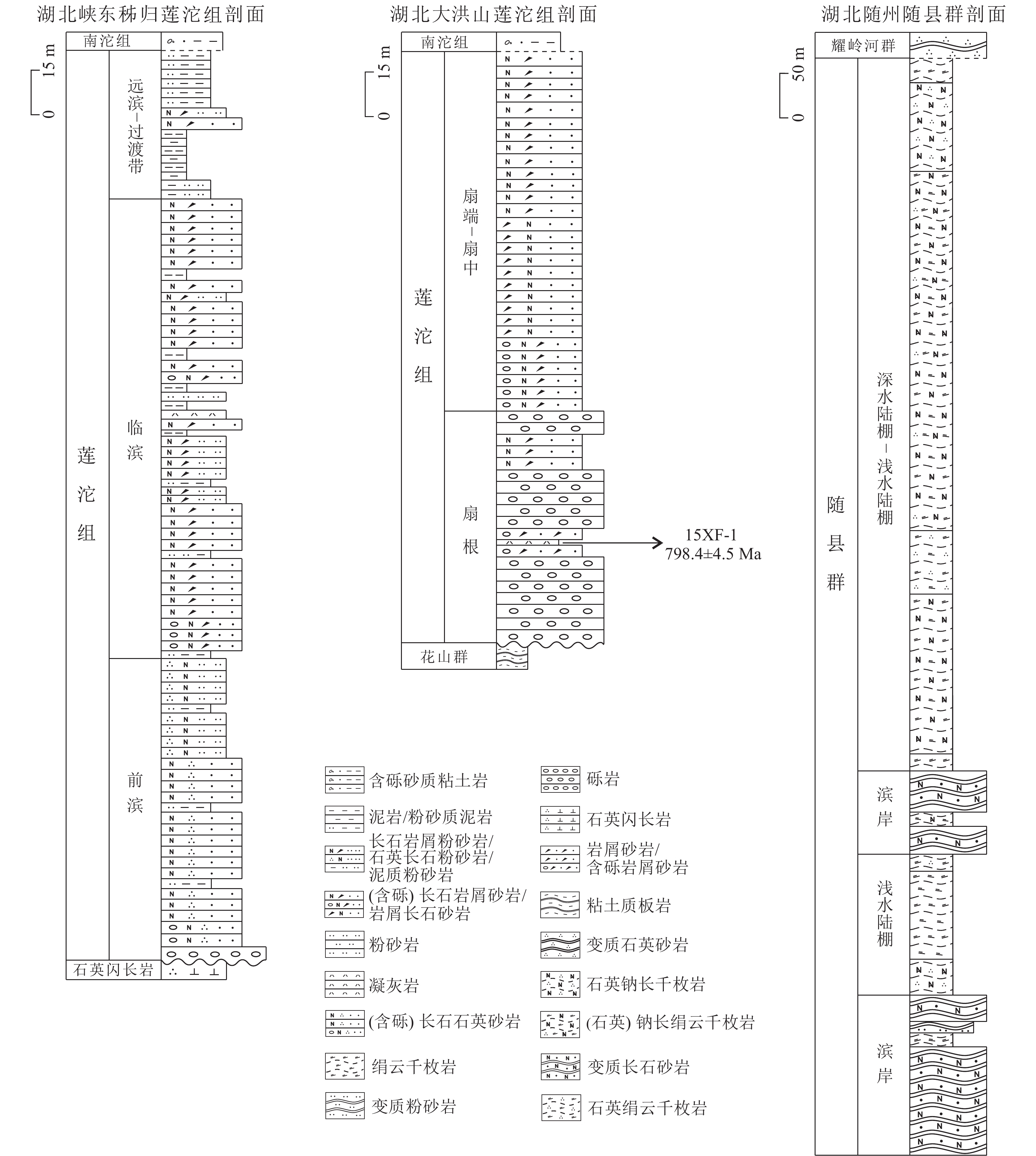Zircon U-Pb age and stratigraphic significance of the tuff from the lowermost Liantuo Formation in the Dahongshan area of the northern Yangtze Block
-
摘要:
扬子陆块北缘莲沱组是华南新元古代的重要地层单元之一,但其沉积时限、区域对比关系、沉积环境与沉积期古地理存在诸多争论。对大洪山地区莲沱组底部的凝灰岩进行了LA-ICP-MS锆石U-Pb定年,获得凝灰岩样品的形成年龄为798.4 ± 4.5 Ma(MSWD = 0.40,n = 13)。结合前人研究成果,将莲沱组的沉积时限限定为800 ~ 714 Ma,区域上可与板溪群及其相当地层中上部、休宁组、澄江组、开建桥组、武当群和随县群进行对比,为“晋宁造山运动”不整合面之上、南华冰期之下的一套裂谷充填产物,代表了裂谷盆地全面打开,沉积范围快速扩大的充填序列,其主体为冲积扇、河流及滨浅海沉积。莲沱沉积时期,扬子陆块北缘形成了一个向北逐渐变深的裂谷盆地,此时大洪山地区的莲沱组为围绕鄂北古隆起分布的冲积扇沉积,向北则变为以随县群为代表的滨浅海—半深海沉积。
Abstract:The Liantuo Formation, exposed on the northern Yangtze Block, is one of the important Neoproterozoic stratigraphic units in South China. However, no consensus has been reached on its depositional period, regional correlation, depositional environment and paleogeographic characteristics so far. In this study, we obtained a zircon LA-ICP-MS U-Pb age of 798.4 ± 4.5 Ma (MSWD = 0.40, n = 13) for the tuff layer from the bottom of the Liantuo Formation in the Dahongshan area. Integrating the previous reported data, the depositional period of the Liantuo Formation was constrained to ca. 800–714 Ma. Regionally, the Liantuo Formation is comparable to the middle-upper part of the Banxi Group and its equivalent strata, as well as to the Xiuning Formation, Chengjiang Formation, Kaijianqiao Formation, Wudang Group and Suixian Group. The Liantuo Formation is a set of rift filling deposition, which rests on the Jinning orogeny unconformity and underlies the Nanhua Glacial Period deposition, representing a filling sequence while the rift basin fully opening and the depositional area rapidly expansion. The depositional sequence is mainly composed of alluvial fan, fluvial and littoral-neritic facies sediments. During the Liantuo Period, the northern Yangtze Block was a rift basin, which gradually deepened to the north. Meanwhile, the Liantuo Formation in the Dahongshan area represents an alluvial fan deposition that distributed around the Northern Hubei Paleo-uplift, and evolves to the littoral-neritic-bathyal deposition that represented by the Suixian Group.
-
沉积地层时限的确定是区域地层划分对比的重要依据,也是进行古地理重建和沉积盆地形成演化研究的重要前提(邓奇等, 2019; 江新胜等, 2020)。近年来,随着锆石原位U-Pb定年技术的广泛应用,中国前寒武纪年代地层格架发生了巨大变革。尤其是大量凝灰岩精确锆石U-Pb年龄的不断报道,为建立区域地层格架、恢复古地理与构造演化史提供了可靠的时间标尺(Jiang et al., 2012; 邓奇等, 2013; 刘军平等, 2021; 杨济远等, 2023)。
莲沱组由刘鸿允和沙庆安(1963)在宜昌市莲沱镇所创的莲沱群演变而来。湖北省地质局三峡地层研究组(1978)改称莲沱组,沿用至今。莲沱组在区域上主要分布在扬子陆块鄂西神农架—峡东地区、鄂东北大洪山地区、鄂东南至赣西北地区,主体为“晋宁造山运动”不整合面之上的一套紫红色粗碎屑岩沉积。由于南华系的初始定义中包含莲沱组,其又与华南新元古代中期裂谷作用和晚期冰期启动密切相关(Wang et al., 2003; Lan et al., 2014, 2015a, 2015b),因此莲沱组的时代、对比关系和属性长期备受关注,也存在较大分歧。一种观点将莲沱组对比于南华冰期地层(高林志等, 2010, 2011; 尹崇玉等, 2013);另一种观点认为莲沱组是新元古代裂谷盆地的产物,与板溪群大体相当(崔晓庄等, 2013; 汪正江等, 2013, 2015; Lan et al., 2014, 2015b; 张启锐, 2014; Wang et al., 2016; 张启锐等, 2016; 邓奇等, 2019)。
目前,莲沱组的顶界年龄已经得到了较好的约束(高维等, 2009; Lan et al., 2015b; 王田等, 2020),但是其底界年龄还存在争论,大多数学者认为在790 ~ 760 Ma之间(冯连君等, 2006; 高林志等, 2010; Du et al., 2013)。另外,由于大洪山地区紧邻南秦岭,莲沱组与南秦岭地区时代相近的随县群的关系、莲沱组沉积时期扬子地区的古地理格局等问题仍有待深入研究和探讨。鉴于此,对扬子陆块北缘大洪山地区莲沱组开展了年代学和沉积学研究,以期为上述问题的解答提供可靠的证据。
1. 区域地质概况及样品特征
研究区位于扬子陆块北缘大洪山地区,其北东侧与南秦岭毗邻(图1)。区内出露的前寒武纪地层为中元古代打鼓石群,新元古代花山群、莲沱组、随县群、南沱组和震旦系。打鼓石群自下而上为太阳寺组、韩家洼组、罗汉岭组、陈家冲组、李家咀组和当铺岭组,主体为碳酸盐岩夹碎屑岩沉积。花山群包括下部洪山寺组和上部六房咀组,其中,洪山寺组主要为一套由砾岩、砂岩组成的碎屑岩系;而六房咀组发育大量的基性火山岩,并夹有泥质板岩、粉砂质板岩等。莲沱组主要分布于王关—肖树湾一带,呈带状展布(图1),地层总厚度约为570 m,其下部以紫红色厚层砂质砾岩及粗粒岩屑长石砂岩为主,上部主要为紫红色厚层砂岩、含砾长石岩屑砂岩、粗粒岩屑长石砂岩及粉砂质泥岩,与下伏地层花山群呈角度不整合接触,与上覆地层南沱组呈平行不整合接触。随县群主要出露于襄阳−广济断裂以东的南秦岭地区,是以碎屑岩−火山碎屑岩为主的变质岩系,未见底。
本次凝灰岩样品15XF-1的采集剖面位于小阜街东南约4 km处,上下均为紫红色含砾岩屑砂岩,剖面出露不连续,但从下至上可划分出3个砾岩和含砾岩屑砂岩的旋回。根据剖面位置和沉积序列(冲积扇的扇根)综合分析,采集的凝灰岩样品15XF-1接近于莲沱组的底部,野外露头呈灰白色(图2),地理坐标为北纬 31°22′15″、东经 113°9′48″。
岩石具晶屑凝灰结构,假流纹构造。岩石主要由晶屑、隐晶质矿物及火山灰组成;其中晶屑主要为石英,大部分边部被熔蚀呈港湾状、不规则状及次圆状,0.10 ~ 1.45 mm,最大者约2.25 mm;岩石整体绢云母化、粘土化,局部发育碳酸盐化。岩屑及火山灰被后期交代形成绢云母。岩石内发育气孔构造,且沿气孔充填有少量绢云母及碳酸盐矿物。隐晶质矿物均以致密状展布。镜下定名为蚀变晶屑凝灰岩(图2)。
2. 分析方法
岩石样品经破碎、淘洗、重液分离和电磁分离后,在双目镜下挑选晶形完好、具有代表性的锆石颗粒粘在树脂台上,打磨抛光,制成样靶,然后对锆石进行反射光、透射光显微照相和阴极发光(CL)图像分析,确定锆石的内部结构和成因,以选取最佳的待测锆石部位(张靖怡等, 2022)。锆石U-Pb定年在中国地质大学(武汉)地质过程与矿产资源国家重点实验室利用激光剥蚀(LA)−电感耦合等离子体质谱仪(ICP-MS)分析完成。激光剥蚀系统为GeoLas 2005,质谱为Agilent 7500a。本次实验采用的激光束斑直径为32 μm,每个时间分辨分析数据包括20 ~ 30 s的空白信号和50 s的样品信号(Hu et al., 2008)。对分析数据的离线处理采用软件ICPMSDataCal(Liu et al., 2008)完成。详细的仪器操作条件和数据处理方法同文献Hu et al.(2008)。
3. 分析结果
样品15XF-1锆石粒度较小,长度一般为50 ~ 100 μm,长宽比以1∶1 ~ 2∶1为主。阴极发光图像中,绝大部分锆石显示明显的岩浆振荡环带结构。根据磨蚀程度,这些锆石可大致分为2类:第一类呈半自形—他形、次圆状—圆状的形态特征;第二类主要为自形,棱角较分明。个别锆石具有核-边结构,核部一般相对较宽,发光较亮;边部较窄,发光弱(图3)。对该样品的54颗锆石进行了54个分析点的U-Pb同位素年龄测定(2个为边部),分析结果列于表1。由于具核-边结构的锆石很少,仅选取2颗边部相对较宽的锆石进行分析(图3),其Th/U值分别为0.04和0.34,测定的年龄分别为2090 ± 30 Ma(分析点06)和1969 ± 37 Ma(分析点08)(图4−a),与崆岭和钟祥地区报道的变质事件年龄相对应(Zhang et al., 2006; Wang et al., 2018)。其余52个分析点的Th/U值为0.30~2.34,指示岩浆锆石特征。如表1所示,只有分析点19、21和53的谐和度小于90%,其余49个点形成了5组年龄,其中最老一组的207Pb/206Pb年龄加权平均值为2434 ± 23 Ma(MSWD = 0.64,n = 7),3组较老锆石的206Pb/238U年龄加权平均值分别为916 ± 13 Ma(MSWD = 1.20,n = 5)、873 ± 6 Ma(MSWD = 0.79,n = 8)和834 ± 4 Ma(MSWD = 0.97,n = 13)(图4−b),这几组年龄应该与区域上报道的岩浆事件有关,如约2470 Ma陡岭杂岩(Hu et al., 2013)、约2440 Ma红安长英麻粒岩(Zhou et al., 2015)、940~870 Ma三里岗岩浆岩(Shi et al., 2007)等。最年轻一组锆石206Pb/238U年龄加权平均值为798.4 ± 4.5 Ma(MSWD = 0.40,n = 13)(图4−a),这组锆石多为自形,较细小、棱角分明且具有明显的岩浆振荡环带特征(图3),所以应为同沉积火山灰喷发形成的锆石,其年龄代表采样凝灰岩的沉积时代。
表 1 大洪山地区莲沱组凝灰岩样品15XF-1 锆石U-Th-Pb 同位素测试结果Table 1. LA-ICP-MS zircon U-Th-Pb isotope data of the tuff sample 15XF-1 from the Liantuo Formation in the Dahongshan area测试点号 Th/U 同位素比值 同位素年龄/Ma 谐和度 207Pb/206Pb 1σ 207Pb/235U 1σ 206Pb/238U 1σ 207Pb/206Pb 1σ 207Pb/235U 1σ 206Pb/238U 1σ 1 0.74 0.0682 0.0028 1.3284 0.0579 0.1401 0.0017 874 92 858 25 845 9 98% 2 1.04 0.0665 0.0026 1.2409 0.0464 0.1361 0.0016 833 81 819 21 823 9 99% 3 0.62 0.0723 0.0026 1.4981 0.0541 0.1502 0.0016 994 74 930 22 902 9 97% 4 0.88 0.0700 0.0038 1.3328 0.0712 0.1396 0.0020 928 112 860 31 842 11 97% 5 0.61 0.0641 0.0027 1.3683 0.0609 0.1541 0.0019 746 89 875 26 924 11 94% 6 0.34 0.1295 0.0022 6.5328 0.1174 0.3629 0.0029 2090 29 2050 16 1996 14 97% 7 0.78 0.0669 0.0019 1.2781 0.0372 0.1379 0.0012 835 61 836 17 833 7 99% 8 0.04 0.1208 0.0025 6.1822 0.1272 0.3687 0.0030 1969 37 2002 18 2024 14 98% 9 0.90 0.0641 0.0029 1.2929 0.0578 0.1457 0.0020 743 90 843 26 877 11 96% 10 0.68 0.0669 0.0026 1.4141 0.0525 0.1548 0.0017 835 81 895 22 928 10 96% 11 0.35 0.1605 0.0027 10.3057 0.1786 0.4627 0.0034 2461 34 2463 16 2452 15 99% 12 0.67 0.0671 0.0021 1.2810 0.0392 0.1381 0.0013 843 65 837 17 834 7 99% 13 0.70 0.0677 0.0023 1.2687 0.0407 0.1362 0.0013 861 69 832 18 823 8 98% 14 0.65 0.0684 0.0020 1.3074 0.0380 0.1383 0.0012 881 60 849 17 835 7 98% 15 0.80 0.0668 0.0027 1.2170 0.0502 0.1319 0.0016 831 90 808 23 799 9 98% 16 0.95 0.0663 0.0017 1.1942 0.0303 0.1305 0.0013 817 58 798 14 791 8 99% 17 1.34 0.0688 0.0025 1.2631 0.0494 0.1320 0.0015 894 76 829 22 799 9 96% 18 0.89 0.0688 0.0026 1.2430 0.0449 0.1317 0.0013 892 78 820 20 798 8 97% 19 0.60 0.1346 0.0022 5.1511 0.0831 0.2761 0.0017 2159 28 1845 14 1572 9 84% 20 0.73 0.0690 0.0018 1.3116 0.0326 0.1379 0.0012 898 47 851 14 833 7 97% 21 0.36 0.1541 0.0024 7.2218 0.1297 0.3383 0.0039 2392 26 2139 16 1878 19 87% 22 0.72 0.0678 0.0047 1.2124 0.0782 0.1325 0.0025 865 144 806 36 802 14 99% 23 0.63 0.0677 0.0024 1.3654 0.0462 0.1462 0.0014 861 73 874 20 880 8 99% 24 1.10 0.0760 0.0037 1.5078 0.0702 0.1456 0.0019 1094 97 934 28 876 11 93% 25 2.34 0.0689 0.0025 1.3442 0.0512 0.1405 0.0018 894 74 865 22 848 10 97% 26 0.86 0.0668 0.0019 1.2303 0.0339 0.1335 0.0012 831 59 814 15 808 7 99% 27 0.74 0.0713 0.0022 1.3684 0.0412 0.1397 0.0014 965 65 875 18 843 8 96% 28 0.80 0.1585 0.0028 10.0194 0.1778 0.4556 0.0034 2439 29 2437 16 2420 15 99% 29 1.06 0.0676 0.0025 1.3232 0.0478 0.1422 0.0016 855 76 856 21 857 9 99% 30 0.67 0.0674 0.0017 1.3079 0.0347 0.1397 0.0014 850 52 849 15 843 8 99% 31 0.72 0.0647 0.0036 1.1488 0.0602 0.1321 0.0017 765 117 777 28 800 10 97% 32 0.58 0.0649 0.0027 1.3006 0.0546 0.1448 0.0018 769 87 846 24 872 10 97% 33 0.73 0.0675 0.0029 1.2647 0.0543 0.1358 0.0018 852 86 830 24 821 10 98% 34 0.30 0.1481 0.0023 7.9588 0.1717 0.3853 0.0057 2324 26 2226 20 2101 27 94% 35 0.95 0.0646 0.0017 1.1673 0.0312 0.1307 0.0014 761 56 785 15 792 8 99% 36 0.72 0.1568 0.0046 9.3008 0.2587 0.4285 0.0083 2421 50 2368 26 2299 38 97% 37 1.28 0.0696 0.0033 1.2627 0.0593 0.1326 0.0016 918 98 829 27 803 9 96% 38 1.08 0.0641 0.0015 1.2254 0.0287 0.1376 0.0011 746 52 812 13 831 6 97% 40 0.93 0.0638 0.0036 1.1491 0.0585 0.1312 0.0021 744 119 777 28 794 12 97% 41 0.71 0.0654 0.0021 1.1958 0.0360 0.1322 0.0011 787 69 799 17 801 7 99% 42 0.76 0.0666 0.0048 1.2716 0.0848 0.1424 0.0023 828 118 833 38 858 13 97% 43 0.76 0.0657 0.0018 1.3292 0.0353 0.1458 0.0012 796 56 859 15 877 7 97% 44 0.75 0.0649 0.0013 1.1864 0.0239 0.1317 0.0011 772 43 794 11 798 6 99% 45 0.59 0.1551 0.0026 9.0871 0.1771 0.4207 0.0046 2403 28 2347 18 2264 21 96% 46 1.05 0.0666 0.0023 1.3850 0.0444 0.1517 0.0016 833 71 883 19 911 9 96% 47 0.92 0.0695 0.0027 1.4732 0.0576 0.1535 0.0018 917 81 919 24 921 10 99% 48 0.70 0.0645 0.0037 1.1637 0.0670 0.1299 0.0023 759 120 784 31 787 13 99% 49 0.66 0.0682 0.0021 1.3713 0.0420 0.1450 0.0015 874 95 877 18 873 8 99% 50 0.55 0.1550 0.0029 8.7684 0.1619 0.4070 0.0028 2402 33 2314 17 2201 13 95% 51 1.02 0.1188 0.0024 6.1083 0.1241 0.3705 0.0030 1939 36 1991 18 2032 14 97% 52 0.57 0.1601 0.0027 10.8034 0.1838 0.4853 0.0037 2457 28 2506 16 2550 16 98% 53 1.00 0.0717 0.0024 1.1364 0.0393 0.1140 0.0011 989 67 771 19 696 7 89% 54 0.41 0.1592 0.0026 10.6614 0.1717 0.4819 0.0034 2448 28 2494 15 2535 15 98% 55 0.57 0.0707 0.0024 1.5472 0.0511 0.1585 0.0016 950 71 949 20 948 9 99% 4. 讨 论
4.1 莲沱组的沉积时限
如前所述,莲沱组主要出露于扬子陆块北缘,主体为一套紫红色的碎屑岩沉积,是扬子陆块新元古代重要的地层单元之一。莲沱组的沉积时限是扬子陆块北缘,乃至整个华南地层划分对比的关键,也是争论的焦点(冯连君等, 2006; 高维等, 2009; 高林志等, 2010; Du et al., 2013; Lan et al., 2014, 2015a, 2015b; 王田等, 2020)。近年来,莲沱组的年代学研究取得了较大进展,但发表的年龄数据主要在鄂西、鄂东南等地区,且多集中在莲沱组中上部。例如,高维等(2009)报道了宜昌田家院子剖面莲沱组顶部凝灰岩的年龄为724 ± 12 Ma。Lan et al.(2015b)获得宜昌王丰岗剖面莲沱组中上部凝灰质粉砂岩的年龄为732 ± 10 Ma、中下部凝灰岩的年龄为777 ± 4 Ma;田家院子剖面莲沱组顶部凝灰质粉砂岩的年龄为714 ± 8 Ma、上部凝灰质粉砂岩的年龄为738 ± 5 Ma。王田等(2020)对鄂东南地区通山石门塘剖面莲沱组进行了年代学研究,获得最大沉积年龄为784 ± 11 Ma,中上部沉积年龄为727 ± 7 Ma。
本文凝灰岩样品15XF-1采自鄂东北大洪山地区,采样剖面的岩性特征明显,为典型的莲沱组紫红色碎屑岩沉积。凝灰岩样品采自近底部层位,虽然不是最底部,但是由于陆相粗碎屑沉积速率较大,因此本文获得的凝灰岩形成年龄798.4 ± 4.5 Ma可以代表莲沱组的底界年龄。Du et al.(2013)报道的大洪山地区莲沱组中下部凝灰岩锆石U-Pb年龄为779 ± 12 Ma,也可以验证本文研究成果的可信度,因此将莲沱组的底界年龄限定为 800 Ma。
目前关于研究区莲沱组的顶部年龄,虽然大洪山地区还没有数据报道,但根据其他地区莲沱组顶部的研究结果,其顶部年龄约为 714 Ma(Lan et al., 2015b)。也有学者认为,由于莲沱组沉积区一直处于古地理高位置,莲沱组顶面是个剥蚀不整合面,约714 Ma的年龄样品层位不是莲沱组沉积的终结顶面(张启锐等, 2016),它不应该比湘黔桂区拱洞组的顶界年龄(约716 Ma)年轻。但在误差范围内,被剥蚀后的莲沱组顶界年龄也可能老于拱洞组的顶界年龄,考虑到Sturtian冰期全球发生的同时性(如阿拉伯—努比亚陆块阿曼地区Huqf超群Ghubrah组冰碛岩的年龄为713.7 ± 0.5 Ma)(Bowring et al., 2007),笔者认为,莲沱组的顶界年龄限定在约714 Ma是合理的。
4.2 莲沱组的区域对比
传统对比方案中一直将莲沱组与澄江组、休宁组、长安组及其相当地层进行对比,并将其置于板溪群及其相当地层之上(陆松年等, 2002; 尹崇玉等, 2007, 2013)。近年来,随着锆石U-Pb定年技术的广泛应用,获得了大批高精度同位素年代学数据,扬子地区新元古代的地层格架得到了较大完善(Jiang et al., 2012; 崔晓庄等, 2013; 邓奇等, 2013, 2019; Lan et al., 2014, 2015b)。
在扬子陆块西北缘汉南地区,邓奇等(2013)报道的西乡群大石沟组下部凝灰岩的锆石U-Pb年龄为789.0 ± 4.4 Ma,与莲沱组下部年龄较一致;其上三郎铺组中上部凝灰岩的锆石U-Pb年龄为760.4 ± 4.5 Ma,也在莲沱组的时限范围内。另外,根据笔者的野外观察,大石沟组和三郎铺组虽然火山活动比较频繁,但总体上也是一套紫红色的冲洪积相碎屑岩沉积,与莲沱组相似,可对比性良好(图5)。
![]() 数据来源:a— Ling et al., 2008; b—Ling et al., 2010; c—Yang et al., 2016; d—薛怀民等, 2011; e—Du et al., 2013; f—邓奇等, 2013; g—Lan et al., 2015b; h—王田等, 2020; i—Wang et al., 2012b; j—邓奇等, 2019; k—Li et al., 2003; l—Zhang et al., 2008; m– Wang et al., 2012a; n—汪正江等, 2013; o—Lan et al., 2014; p—崔晓庄等, 2016; q—Jiang et al., 2012; r—崔晓庄等, 2013; s—Jiang et al., 2016; t—卓皆文等, 2015Figure 5. Correlation of the Neoproterozoic strata along the periphery margins of Yangtze Block
数据来源:a— Ling et al., 2008; b—Ling et al., 2010; c—Yang et al., 2016; d—薛怀民等, 2011; e—Du et al., 2013; f—邓奇等, 2013; g—Lan et al., 2015b; h—王田等, 2020; i—Wang et al., 2012b; j—邓奇等, 2019; k—Li et al., 2003; l—Zhang et al., 2008; m– Wang et al., 2012a; n—汪正江等, 2013; o—Lan et al., 2014; p—崔晓庄等, 2016; q—Jiang et al., 2012; r—崔晓庄等, 2013; s—Jiang et al., 2016; t—卓皆文等, 2015Figure 5. Correlation of the Neoproterozoic strata along the periphery margins of Yangtze Block出露于南秦岭的武当山群和随县群,在岩石组合特征上与莲沱组差异明显,但根据可靠的同位素年龄,武当山群的火山岩形成于755 ± 3 Ma(Ling et al., 2008)、最大沉积年龄为约780 Ma(Ling et al., 2010),随县群中部流纹英安质凝灰岩的年龄为763 ± 7 Ma(薛怀民等, 2011)、上部凝灰质粉砂岩的年龄为727 ± 5 Ma(Yang et al., 2016),都处于莲沱组的沉积时限内。因此,笔者认为武当山群和随县群可与莲沱组进行对比(图5)。
在扬子陆块东南缘浙皖赣邻区,浙北休宁组下部和上部凝灰岩锆石U-Pb年龄分别为785 ± 3 Ma和728 ± 7 Ma(邓奇等, 2019);赣东北休宁组凝灰岩锆石U-Pb年龄为734 ± 6 Ma(王田等, 2020);而皖南铺岭组火山岩锆石U-Pb年龄为约760 Ma(Wang et al., 2012b),都在莲沱组的年代范围内。此外,据笔者的野外观察,这些地层的岩性特征与沉积构造等均与莲沱组相似,可以进行对比(图5)。
在湘黔桂地区,湘北板溪群上部五强溪组的顶、底界年龄分别为809 ±8 Ma(Zhang et al., 2008)、719 ± 10 Ma(Wang et al., 2012a),与莲沱组基本一致;黔东南下江群番召组的底部年龄为802 ± 2 Ma,顶部隆里组凝灰岩的锆石年龄为733 ± 18 Ma(汪正江等, 2013);桂北丹洲群自下而上分为白竹组、合桐组、三门街组和拱洞组,其中合桐组二段凝灰岩夹层的年龄为801 ± 4 Ma(崔晓庄等, 2016),拱洞组顶部凝灰岩锆石年龄为716 ± 3 Ma(Lan et al., 2014),基本处于莲沱组的沉积时限内。因此,笔者认为莲沱组可与板溪群及其相当地层的中上部进行对比(图5)。
扬子陆块西缘澄江组的岩性特征和沉积环境与莲沱组非常相似,总体为一套紫红色的陆相碎屑岩沉积,根据Jiang et al.(2012)和崔晓庄等(2013)的研究,澄江组的顶界年龄约为725 Ma,底界年龄约为800 Ma。开建桥组的底部凝灰岩年龄为801 ± 7 Ma(卓皆文等, 2015)、顶部凝灰岩年龄约为717 Ma(Jiang et al., 2016),可以将开建桥组的沉积时限限定在800 ~ 717 Ma。因此,莲沱组可与澄江组、开建桥组进行对比(图5)。
本次研究结果表明,扬子陆块北缘莲沱组的沉积时限为 800 ~ 714 Ma。结合前人研究成果,莲沱组可与扬子陆块西北缘西乡群大石沟组和三郎铺组、南秦岭武当群和随县群、浙皖赣休宁组、湘黔桂板溪群及其相当地层中上部、西缘澄江组和开建桥组进行对比。
4.3 莲沱期大洪山地区的沉积环境与古地理
扬子地区莲沱组及其相当地层为“晋宁造山运动”不整合面之上、南华冰期之下的一套裂谷充填产物(Wang et al., 2003; 邓奇等, 2023),代表了裂谷盆地全面打开,沉积范围快速扩展后的充填序列,其主体为冲积扇、河流及滨浅海沉积。如前所述,南秦岭随县群虽然在岩性上与莲沱组相差较大,但研究区紧邻南秦岭,且它们的形成时代相近,因此应为有联系的同期异相地层。
据笔者野外观察,峡东地区莲沱组岩石总体的结构和成分成熟度较高。如秭归莲沱组剖面底部为石英质砾岩,分选性和磨圆度较好;而在宜昌莲沱大桥剖面,可见席状的紫红色长石石英砂岩,发育平行层理,这些都是典型的滨岸前滨沉积特征(图6)。大洪山地区的莲沱组与峡东地区莲沱组的区别较大(图6),主体为一套紫红色具较低结构和成分成熟度的陆相碎屑岩组合,由紫红色厚层—块状砾岩、含砾岩屑砂岩、长石岩屑砂岩、凝灰岩等组成,其与下伏花山群六房咀组板岩呈角度不整合接触,接触面为一个起伏不平的侵蚀面(图版Ⅰ−a)。界面上为灰紫色厚层块状砾岩,砾石成分复杂,有砂岩、泥岩、石英岩、花岗岩、基性岩等,呈棱角—次圆状,分选性差,砾岩杂基支撑,砂泥质胶结(图版Ⅰ−b),为冲积扇扇根泥石流沉积;向上砾石粒度减小,分选性、磨圆度变好,逐渐出现颗粒支撑结构和叠瓦状排列,牵引流作用加强,砾岩之上的砂岩分选性较好,可见平行层理(图版Ⅰ−c),为冲积扇扇中辫状河沉积;再向上为紫红色中层状砂岩,见板状交错层理,为冲积扇扇端砂质辫状河水道充填沉积。向南至京山县绿林镇王关,莲沱组底部砾岩粒度变小,分选性和磨圆度均变好,显现叠瓦状排列,为冲积扇扇根砾质辫状河水道充填沉积(图版Ⅰ−d);向上为含砾长石岩屑砂岩、岩屑长石砂岩,可见透镜状水道砂体,砂体底面见重荷模构造,发育斜层理、楔状交错层理(图版Ⅰ−e, f),具冲积扇扇中砂质辫状河水道充填沉积特征。如前所述,本次采样的小阜街剖面从下至上可识别出3个紫红色砾岩和含砾岩屑砂岩旋回,砾岩杂基支撑,砂泥质胶结,砾石分选性和磨圆度较差,含砾岩屑砂岩成层性不明显,为冲积扇扇根泥石流和水道充填沉积。
随县群主要出露于襄阳−广济断裂以东的南秦岭地区,是以碎屑岩−火山碎屑岩为主的变质岩系。下部以碎屑岩为主,从下至上可显示出3个沉积韵律:变质细粒长石砂岩、含砂质绢云母千枚岩及变质粉砂岩,变质中粗粒长石砂岩、砂质绢云钠长石英千枚岩、钠长绢云千枚岩、绿泥千枚岩,变质泥质细粒长石砂岩、变质含泥质硅质细粒长石砂岩及绢云千枚岩、局部见火山碎屑岩。原岩为细粒长石砂岩、粉砂岩、含砂粘土岩、含砂泥质硅质岩及硅质粘土岩(图6),因此当时可能为滨浅海环境。上部岩性主要为石英钠长绢云千枚岩、含绿帘钠长石英绢云千枚岩、绢云千枚岩等(图6);岩石可见变余凝灰结构、变余斑状结构、鳞片变晶结构,其原岩为酸性凝灰岩、凝灰质粘土岩、含硅质粘土岩等,其沉积环境可能为含火山活动的浅海—半深海环境。
莲沱时期,扬子陆块北缘裂谷盆地范围扩大,盆地主边界断裂的控盆作用减弱,裂谷盆地幼年期的小型半地堑盆地相互连通,形成了一个向北逐渐变深的裂谷盆地。盆地的西南部为上扬子隆起,东南部为鄂北隆起,2个隆起之间为海峡相隔。此时,大洪山地区的莲沱组为围绕鄂北古隆起分布的冲击扇(入水为扇三角洲沉积),向北则变为以随县群为代表的滨浅海—半深海沉积。
5. 结 论
(1)锆石LA-ICP-MS U-Pb定年结果表明,扬子陆块北缘大洪山地区莲沱组底部凝灰岩样品的形成年龄为798.4 ± 4.5 Ma。
(2)结合区域年龄数据,莲沱组的沉积时限为800 ~ 714 Ma,区域上可与板溪群及其相当地层中上部、休宁组、澄江组、开建桥组、武当群和随县群进行对比。
(3)莲沱沉积时期,扬子陆块北缘形成了一个向北逐渐变深的裂谷盆地,此时大洪山地区的莲沱组为围绕鄂北古隆起分布的冲积扇沉积,向北则变为以随县群为代表的滨浅海—半深海沉积。
-
图 1 研究区大地构造位置(a,据汪正江等,2015修改)及大洪山地区前寒武纪地质简图和采样位置(b,据Deng et al., 2013修改)
Figure 1. The tectonic position of the study area (a), simplified Precambrian geological map and sampling location in the Dahongshan area (b)
图 5 扬子地块周缘新元古代地层对比简图(据邓奇等, 2016, 2019修改)
数据来源:a— Ling et al., 2008; b—Ling et al., 2010; c—Yang et al., 2016; d—薛怀民等, 2011; e—Du et al., 2013; f—邓奇等, 2013; g—Lan et al., 2015b; h—王田等, 2020; i—Wang et al., 2012b; j—邓奇等, 2019; k—Li et al., 2003; l—Zhang et al., 2008; m– Wang et al., 2012a; n—汪正江等, 2013; o—Lan et al., 2014; p—崔晓庄等, 2016; q—Jiang et al., 2012; r—崔晓庄等, 2013; s—Jiang et al., 2016; t—卓皆文等, 2015
Figure 5. Correlation of the Neoproterozoic strata along the periphery margins of Yangtze Block
表 1 大洪山地区莲沱组凝灰岩样品15XF-1 锆石U-Th-Pb 同位素测试结果
Table 1 LA-ICP-MS zircon U-Th-Pb isotope data of the tuff sample 15XF-1 from the Liantuo Formation in the Dahongshan area
测试点号 Th/U 同位素比值 同位素年龄/Ma 谐和度 207Pb/206Pb 1σ 207Pb/235U 1σ 206Pb/238U 1σ 207Pb/206Pb 1σ 207Pb/235U 1σ 206Pb/238U 1σ 1 0.74 0.0682 0.0028 1.3284 0.0579 0.1401 0.0017 874 92 858 25 845 9 98% 2 1.04 0.0665 0.0026 1.2409 0.0464 0.1361 0.0016 833 81 819 21 823 9 99% 3 0.62 0.0723 0.0026 1.4981 0.0541 0.1502 0.0016 994 74 930 22 902 9 97% 4 0.88 0.0700 0.0038 1.3328 0.0712 0.1396 0.0020 928 112 860 31 842 11 97% 5 0.61 0.0641 0.0027 1.3683 0.0609 0.1541 0.0019 746 89 875 26 924 11 94% 6 0.34 0.1295 0.0022 6.5328 0.1174 0.3629 0.0029 2090 29 2050 16 1996 14 97% 7 0.78 0.0669 0.0019 1.2781 0.0372 0.1379 0.0012 835 61 836 17 833 7 99% 8 0.04 0.1208 0.0025 6.1822 0.1272 0.3687 0.0030 1969 37 2002 18 2024 14 98% 9 0.90 0.0641 0.0029 1.2929 0.0578 0.1457 0.0020 743 90 843 26 877 11 96% 10 0.68 0.0669 0.0026 1.4141 0.0525 0.1548 0.0017 835 81 895 22 928 10 96% 11 0.35 0.1605 0.0027 10.3057 0.1786 0.4627 0.0034 2461 34 2463 16 2452 15 99% 12 0.67 0.0671 0.0021 1.2810 0.0392 0.1381 0.0013 843 65 837 17 834 7 99% 13 0.70 0.0677 0.0023 1.2687 0.0407 0.1362 0.0013 861 69 832 18 823 8 98% 14 0.65 0.0684 0.0020 1.3074 0.0380 0.1383 0.0012 881 60 849 17 835 7 98% 15 0.80 0.0668 0.0027 1.2170 0.0502 0.1319 0.0016 831 90 808 23 799 9 98% 16 0.95 0.0663 0.0017 1.1942 0.0303 0.1305 0.0013 817 58 798 14 791 8 99% 17 1.34 0.0688 0.0025 1.2631 0.0494 0.1320 0.0015 894 76 829 22 799 9 96% 18 0.89 0.0688 0.0026 1.2430 0.0449 0.1317 0.0013 892 78 820 20 798 8 97% 19 0.60 0.1346 0.0022 5.1511 0.0831 0.2761 0.0017 2159 28 1845 14 1572 9 84% 20 0.73 0.0690 0.0018 1.3116 0.0326 0.1379 0.0012 898 47 851 14 833 7 97% 21 0.36 0.1541 0.0024 7.2218 0.1297 0.3383 0.0039 2392 26 2139 16 1878 19 87% 22 0.72 0.0678 0.0047 1.2124 0.0782 0.1325 0.0025 865 144 806 36 802 14 99% 23 0.63 0.0677 0.0024 1.3654 0.0462 0.1462 0.0014 861 73 874 20 880 8 99% 24 1.10 0.0760 0.0037 1.5078 0.0702 0.1456 0.0019 1094 97 934 28 876 11 93% 25 2.34 0.0689 0.0025 1.3442 0.0512 0.1405 0.0018 894 74 865 22 848 10 97% 26 0.86 0.0668 0.0019 1.2303 0.0339 0.1335 0.0012 831 59 814 15 808 7 99% 27 0.74 0.0713 0.0022 1.3684 0.0412 0.1397 0.0014 965 65 875 18 843 8 96% 28 0.80 0.1585 0.0028 10.0194 0.1778 0.4556 0.0034 2439 29 2437 16 2420 15 99% 29 1.06 0.0676 0.0025 1.3232 0.0478 0.1422 0.0016 855 76 856 21 857 9 99% 30 0.67 0.0674 0.0017 1.3079 0.0347 0.1397 0.0014 850 52 849 15 843 8 99% 31 0.72 0.0647 0.0036 1.1488 0.0602 0.1321 0.0017 765 117 777 28 800 10 97% 32 0.58 0.0649 0.0027 1.3006 0.0546 0.1448 0.0018 769 87 846 24 872 10 97% 33 0.73 0.0675 0.0029 1.2647 0.0543 0.1358 0.0018 852 86 830 24 821 10 98% 34 0.30 0.1481 0.0023 7.9588 0.1717 0.3853 0.0057 2324 26 2226 20 2101 27 94% 35 0.95 0.0646 0.0017 1.1673 0.0312 0.1307 0.0014 761 56 785 15 792 8 99% 36 0.72 0.1568 0.0046 9.3008 0.2587 0.4285 0.0083 2421 50 2368 26 2299 38 97% 37 1.28 0.0696 0.0033 1.2627 0.0593 0.1326 0.0016 918 98 829 27 803 9 96% 38 1.08 0.0641 0.0015 1.2254 0.0287 0.1376 0.0011 746 52 812 13 831 6 97% 40 0.93 0.0638 0.0036 1.1491 0.0585 0.1312 0.0021 744 119 777 28 794 12 97% 41 0.71 0.0654 0.0021 1.1958 0.0360 0.1322 0.0011 787 69 799 17 801 7 99% 42 0.76 0.0666 0.0048 1.2716 0.0848 0.1424 0.0023 828 118 833 38 858 13 97% 43 0.76 0.0657 0.0018 1.3292 0.0353 0.1458 0.0012 796 56 859 15 877 7 97% 44 0.75 0.0649 0.0013 1.1864 0.0239 0.1317 0.0011 772 43 794 11 798 6 99% 45 0.59 0.1551 0.0026 9.0871 0.1771 0.4207 0.0046 2403 28 2347 18 2264 21 96% 46 1.05 0.0666 0.0023 1.3850 0.0444 0.1517 0.0016 833 71 883 19 911 9 96% 47 0.92 0.0695 0.0027 1.4732 0.0576 0.1535 0.0018 917 81 919 24 921 10 99% 48 0.70 0.0645 0.0037 1.1637 0.0670 0.1299 0.0023 759 120 784 31 787 13 99% 49 0.66 0.0682 0.0021 1.3713 0.0420 0.1450 0.0015 874 95 877 18 873 8 99% 50 0.55 0.1550 0.0029 8.7684 0.1619 0.4070 0.0028 2402 33 2314 17 2201 13 95% 51 1.02 0.1188 0.0024 6.1083 0.1241 0.3705 0.0030 1939 36 1991 18 2032 14 97% 52 0.57 0.1601 0.0027 10.8034 0.1838 0.4853 0.0037 2457 28 2506 16 2550 16 98% 53 1.00 0.0717 0.0024 1.1364 0.0393 0.1140 0.0011 989 67 771 19 696 7 89% 54 0.41 0.1592 0.0026 10.6614 0.1717 0.4819 0.0034 2448 28 2494 15 2535 15 98% 55 0.57 0.0707 0.0024 1.5472 0.0511 0.1585 0.0016 950 71 949 20 948 9 99% -
Bowring S A, Grotzinger J P, Condon D J, et al. 2007. Geochronologic constraints on the chronostratigraphic framework of the Neoproterozoic Huqf Supergroup Sultanate of Oman[J]. American Journal of Science, 307: 1097−1145. doi: 10.2475/10.2007.01
Deng Q, Wang J, Wang Z J, et al. 2013. Continental flood basalts of the Huashan Group, northern margin of the Yangtze block−implications for the breakup of Rodinia[J]. International Geology Review, 55(15): 1865−1884. doi: 10.1080/00206814.2013.799257
Du Q D, Wang Z J, Wang J, et al. 2013. Geochronology and paleoenvironment of the pre−Sturtian glacial strata: Evidence from the Liantuo Formation in the Nanhua rift basin of the Yangtze Block, South China[J]. Precambrian Research, 233: 118−131. doi: 10.1016/j.precamres.2013.04.012
Hu J, Liu X C, Chen L Y, et al. 2013. A ~2.5 Ga magmatic event at the northern margin of the Yangtze craton: Evidence from U-Pb dating and Hf isotope analysis of zircons from the Douling Complex in the South Qinling orogen[J]. Chinese Science Bulletin, 58: 3564−3579. doi: 10.1007/s11434-013-5904-1
Hu Z C, Gao S, Liu Y S, et al. 2008. Signal enhancement in laser ablation ICP-MS by addition of nitrogen in the central channel gas[J]. Journal of Analytical Atomic Spectrometry, 23: 1093−1101. doi: 10.1039/b804760j
Jiang X S, Wang J, Cui X Z, et al. 2012. Zircon SHRIMP U-Pb geochronology of the Neoproterozoic Chengjiang Formation in central Yunnan Province(SW China) and its geological significance[J]. Sci. China (Earth Sci), 55(11): 1815−1826. doi: 10.1007/s11430-012-4530-0
Jiang Z F, Cui X Z, Jiang X S, et al. 2016. New zircon U-Pb ages of the pre−Sturtian rift successions from the western Yangtze Block, South China and their geological significance[J]. International Geology Review, 58(9): 1064−1075. doi: 10.1080/00206814.2016.1141719
Lan Z W, Li X H, Zhu M Y, et al. 2014. A rapid and synchronous initiation of the wide spread Cryogenian glaciations[J]. Precambrian Research, 255: 401−411. doi: 10.1016/j.precamres.2014.10.015
Lan Z W, Li X H, Zhang Q R, et al. 2015a. Global synchronous initiation of the 2nd episode of Sturtian glaciation: SIMS zircon U-Pb and O isotope evidence from the Jiangkou Group, South China[J]. Precambrian Research, 267: 28−38. doi: 10.1016/j.precamres.2015.06.002
Lan Z W, Li X H, Zhu M Y, et al. 2015b. Revisiting the Liantuo Formation in Yangtze Block, South China: SIMS U-Pb zircon age constraints and regional and global significance[J]. Precambrian Research, 263: 123−141. doi: 10.1016/j.precamres.2015.03.012
Li Z X, Li X H, Kinny P D, et al. 2003. Geochronology of Neoproterozoic syn−rift magmatism in the Yangtze Craton, South China and correlations with other continents: evidence for a mantle superplume that broke up Rodinia[J]. Precambrain Research, 122: 85−109. doi: 10.1016/S0301-9268(02)00208-5
Ling W L, Ren B F, Duan R C, et al. 2008. Timing of the Wudangshan, Yaolinghe volcanic sequences and mafic sills in South Qinling: U-Pb zircon geochronology and tectonic implication[J]. Chinese Science Bulletin, 53: 2192−2199. doi: 10.1007/s11434-008-0269-6
Ling W L, Duan R C, Liu X M, et al. 2010. U-Pb dating of detrital zircons from the Wudangshan Group in the South Qinling and its geological significance[J]. Chinese Science Bulletin, 55: 2440−2448. doi: 10.1007/s11434-010-3095-6
Liu Y S, Hu Z C, Gao S, et al. 2008. In situ analysis of major and trace elements of anhydrous minerals by LA-ICP-MS without applying an internal standard[J]. Chemical Geology, 257(1/2): 34−43.
Shi Y R, Liu D Y, Zhang Z Q, et al. 2007. SHRIMP zircon U-Pb dating of gabbro and granite from the Huashan ophiolite, Qinling orogenic belt, China: Neoproterozoic suture on the northern margin of the Yangtze Craton[J]. Acta Geologica Sinica, 81(2): 239−243. doi: 10.1111/j.1755-6724.2007.tb00947.x
Wang J, Li Z X. 2003. History of Neoproterozoic rift basins in South China: implications for Rodinia break−up[J]. Precambrian Research, 122: 141−158. doi: 10.1016/S0301-9268(02)00209-7
Wang K, Li Z X, Dong S W, et al. 2018. Early crustal evolution of the Yangtze Craton, South China: New constraints from zircon U-Pb-Hf isotopes and geochemistry of ca. 2.9–2.6 Ga granitic rocks in the Zhongxiang Complex[J]. Precambrian Research, 314: 325−352. doi: 10.1016/j.precamres.2018.05.016
Wang X C, Li X H, Li Z X, et al. 2012a. Episodic Precambrian crust growth: Evidence from U-Pb ages and Hf-O isotopes of zircon in the Nanhua Basin, central South China[J]. Precambrian Research, 222/223: 386−403.
Wang X L, Shu L S, Xing G F, et al. 2012b. Post−orogenic extension in the eastern part of the Jiangnan orogen: Evidence from ca 800-760 Ma volcanic rocks[J]. Precambrain Research, 222/223: 404−423. doi: 10.1016/j.precamres.2011.07.003
Wang Z J, Wang J, Du Q D, et al. 2016. Geochronological and geochemical evidence for the sedimentary transformation from the Banxi Period to the Nanhua Glacial Period[J]. Acta Geologica Sinica, 90(5): 1915−1916. doi: 10.1111/1755-6724.12830
Yang Y N, Wang X C, Li Q L, et al. 2016. Integrated in situ U-Pb age and Hf-O analyses of zircon from Suixian Group in northern Yangtze: New insights into the Neoproterozoic low-δ18O magmas in the South China Block[J]. Precambrian Research, 273: 151−164. doi: 10.1016/j.precamres.2015.12.008
Zhang S B, Zheng Y F, Wu Y B, et al. 2006. Zircon U-Pb age and Hf-O isotope evidence for Paleoproterozoic metamorphic event in South China[J]. Precambrian Research, 151: 265−288. doi: 10.1016/j.precamres.2006.08.009
Zhang S H, Jiang G Q, Dong J, et al. 2008. New SHRIMP U-Pb age from the Wuqiangxi Formation of Banxi Group: implications for rifting and stratigraphic erosion associated with the early Cryogenian (Sturtian) glaciation in South China[J]. Sci. China Ser D (Earth Sci), 51(11): 1537−1544. doi: 10.1007/s11430-008-0119-z
Zhou L G, Xia Q X, Zheng Y F, et al. 2015. Tectonic evolution from oceanic subduction to continental collision during the closure of Paleotethyan ocean: geochronological and geochemical constraints from metamorphic rocks in the Hong’an orogen[J]. Gondwana Research, 28(1): 348−370. doi: 10.1016/j.gr.2014.03.009
崔晓庄, 江新胜, 邓奇, 等. 2016. 桂北地区丹洲群锆石U-Pb年代学及对华南新元古代裂谷作用期次的启示[J]. 大地构造与成矿学, 40(5): 1049−1063. 崔晓庄, 江新胜, 王剑, 等. 2013. 滇中新元古代澄江组层型剖面锆石U-Pb年代学及其地质意义[J]. 现代地质, 27(3): 547−556. doi: 10.3969/j.issn.1000-8527.2013.03.005 邓奇, 王剑, 汪正江, 等. 2013. 扬子北缘西乡群大石沟组和三郎铺组凝灰岩锆石U-Pb年龄及其地质意义[J]. 吉林大学学报(地球科学版), 43(3): 797−808. 邓奇, 王剑, 汪正江, 等. 2016. 江南造山带新元古代中期(830~750 Ma)岩浆活动及对构造演化的制约[J]. 大地构造与成矿学, 40(4): 753−771. 邓奇, 汪正江, 杨菲, 等. 2019. 浙西北建德地区休宁组沉积时限的厘定: 来自凝灰岩锆石U-Pb年代学的制约[J]. 地质学报, 93(2): 414−427. doi: 10.3969/j.issn.0001-5717.2019.02.010 邓奇, 崔晓庄, 汪正江, 等. 2023. 扬子陆块北缘构造演化新认识: 来自原花山群年代学和地球化学的制约[J]. 沉积与特提斯地质, 43(1): 212−225. doi: 10.3969/j.issn.1009-3850.2023.01.016 冯连君, 储雪蕾, 张同钢, 等. 2006. 莲沱砂岩——南华大冰期前气候转冷的沉积记录[J]. 岩石学报, 22(9): 2387−2393. doi: 10.3321/j.issn:1000-0569.2006.09.015 高林志, 丁孝忠, 曹茜, 等. 2010. 中国晚前寒武纪年表和年代地层序列[J]. 中国地质, 37(4): 1014−1020. 高林志, 丁孝忠, 庞维华, 等. 2011. 中国中—新元古代地层年表的修正——锆石U-Pb年龄对年代地层的制约[J]. 地层学杂志, 35(1): 1−7. 高维, 张传恒. 2009. 长江三峡黄陵花岗岩与莲沱组凝灰岩的锆石SHRIMP U-Pb年龄及其构造地层意义[J]. 地质通报, 28(1): 45−50. doi: 10.3969/j.issn.1671-2552.2009.01.006 江新胜, 崔晓庄, 卓皆文, 等. 2020. 华南扬子陆块西缘新元古代康滇裂谷盆地开启时间新证据[J]. 沉积与特提斯地质, 40(3): 31−37. 刘鸿允, 沙庆安. 1963. 长江峡东区震旦系新见[J]. 地质科学, 4(4): 177−187. 刘军平, 宛胜, 李静, 等. 2021. 滇中易门地区古元古界易门群罗洼垤组火山岩锆石U-Pb年龄及其构造热事件[J]. 地质通报, 40(7): 1024−1032. 陆松年. 2002. 关于中国新元古界划分几个问题的讨论[J]. 地质评论, 48(3): 241−248. 王田, 汪正江, 肖渊甫, 等. 2020. 扬子陆块新元古代首次冰期前的区域沉降及其沉积响应研究[J]. 地质论评, 66(4): 1060−1080. 汪正江, 许效松, 杜秋定, 等. 2013. 南华冰期的底界讨论: 来自沉积学与同位素年代学证据[J]. 地球科学进展, 28(4): 477−489. 汪正江, 王剑, 江新胜, 等. 2015. 华南扬子地区新元古代地层划分对比研究新进展[J]. 地质论评, 61(1): 1−22. 薛怀民, 马芳, 宋永勤. 2011. 扬子克拉通北缘随(州)—枣(阳)地区新元古代变质岩浆岩的地球化学和 SHRIMP锆石U-Pb年代学研究[J]. 岩石学报, 27(4): 1116−1130. 杨济远, 李杰, 白春东, 等. 2023. 冀西北宣化盆地侏罗纪九龙山组凝灰岩形成时代、构造环境及地质意义[J]. 西北地质, 56(6): 314−328. 尹崇玉, 柳永清, 高林志, 等. 2007. 震旦(伊迪卡拉)纪早期磷酸盐化生物群—瓮安生物群特征及其环境演化[M]. 北京: 地质出版社: 1−132. 尹崇玉, 高林志. 2013. 中国南华系的范畴、时限及地层划分[J]. 地层学杂志, 37(4): 534−541. 张靖怡, 张舒, 张赞赞, 等. 2022. 北淮阳东端牛王寨岩体年代学及地球化学研究: 对大别造山带早白垩世深部地质过程的制约[J]. 华东地质, 43(2): 141−153. 张启锐. 2014. 关于南华系底界年龄780 Ma数值的讨论[J]. 地层学杂志, 38(3): 336−339. 张启锐, 兰中伍. 2016. 南华系、莲沱组年龄问题的讨论[J]. 地层学杂志, 40(3): 297−301. 卓皆文, 江新胜, 王剑, 等. 2015. 川西新元古代苏雄组层型剖面底部豆状熔结凝灰岩LA-ICP-MS锆石U-Pb 年龄及其地质意义[J]. 沉积与特提斯地质, 35(4): 85−91. -
期刊类型引用(6)
1. 邓奇,汪正江,丛峰,宁括步,任光明,崔晓庄,熊国庆,刘家洪. 扬子陆块西北缘米仓山地区新元古代早期沉积盆地演化:沉积序列与锆石U-Pb年代学证据. 地质学报. 2024(11): 3354-3367 .  百度学术
百度学术
2. 邓奇,汪正江,宁括步,崔晓庄,熊国庆,任光明,任飞. 扬子陆块西北缘旺苍地区火地垭群沉积时代、物源及构造意义——来自碎屑锆石U-Pb年代学的约束. 沉积学报. 2024(06): 1948-1957 .  百度学术
百度学术
3. 李夔洲,侯明才,赵子霖,迟宇超,黄志发. 扬子陆块北缘大洪山地区莲沱组物源分析——来自沉积学和碎屑锆石U-Pb年代学的证据. 沉积学报. 2024(06): 1958-1970 .  百度学术
百度学术
4. 陈风霖,王剑,崔晓庄,沈利军,李夔洲,庞维华,任飞. 扬子西缘峨边群碎屑锆石年代学特征及其地质意义. 沉积学报. 2024(06): 1936-1947 .  百度学术
百度学术
5. 程锦翔,邓敏,杨贵来,余谦. 四川盐源地区名胜剖面志留系龙马溪组黑色泥页岩地球化学特征及物源构造背景分析. 沉积与特提斯地质. 2024(04): 840-853 .  百度学术
百度学术
6. 杨振宁,蔡晓芸,杨坤光,刘雨,李宁宁. 扬子北缘大洪山造山带中新元古代基性岩和浊积岩的年代学和地球化学研究:对弧后盆地演化的指示. 岩石学报. 2023(05): 1423-1440 .  百度学术
百度学术
其他类型引用(2)




 下载:
下载:






